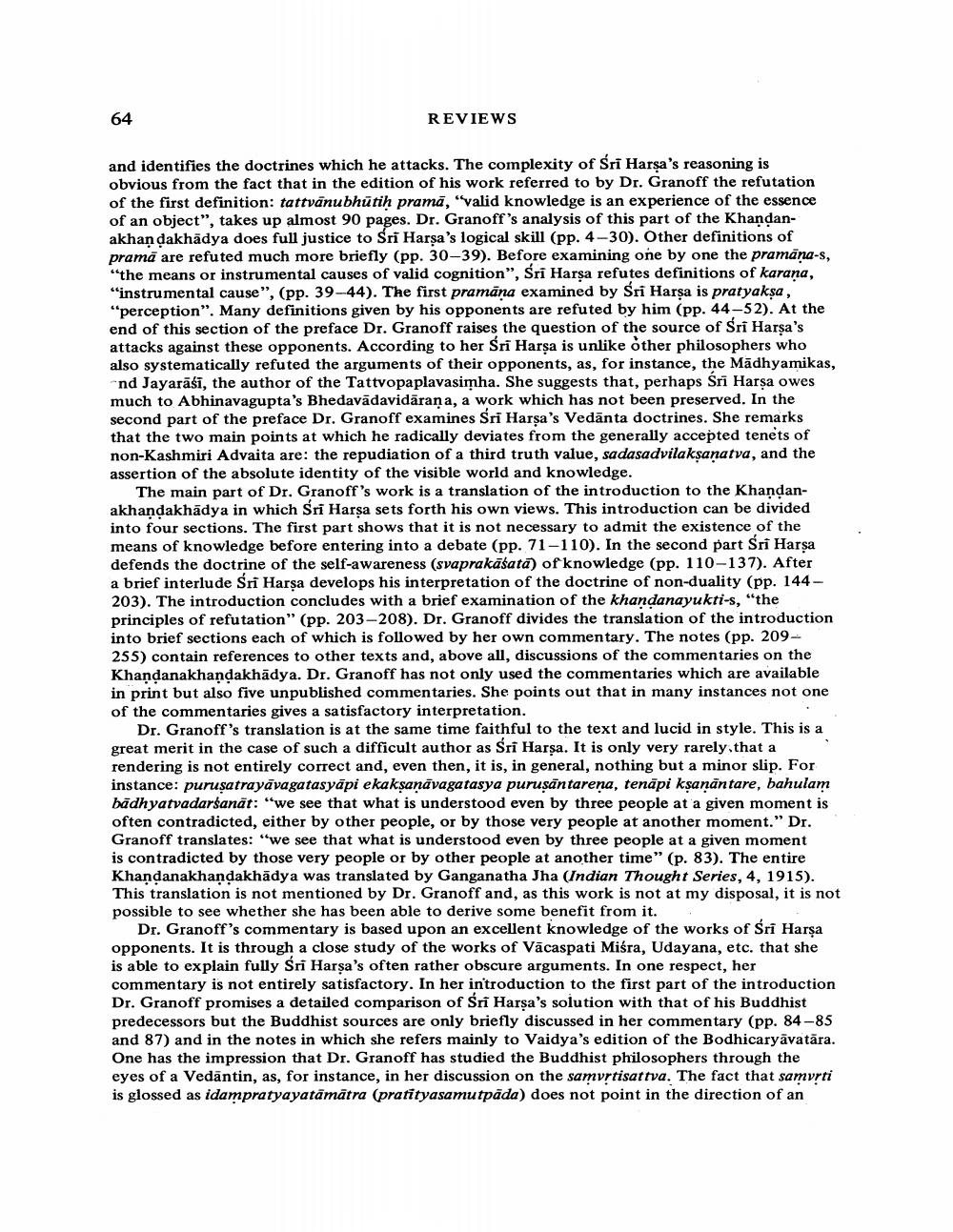Book Title: Book Reviews Author(s): J W De Jong Publisher: J W De Jong View full book textPage 2
________________ 64 REVIEWS and identifies the doctrines which he attacks. The complexity of Sri Harsa's reasoning is obvious from the fact that in the edition of his work referred to by Dr. Granoff the refutation of the first definition: tattvānubhūtih pramā, "valid knowledge is an experience of the essence of an object", takes up almost 90 pages. Dr. Granoff's analysis of this part of the Khandanakhan dakhădya does full justice to Sri Harsa's logical skill (pp. 4-30). Other definitions of pramā are refuted much more briefly (pp. 30-39). Before examining one by one the pramāna-s, "the means or instrumental causes of valid cognition", Sri Harsa refutes definitions of karana, “instrumental cause", (pp. 39-44). The first pramāna examined by Sri Harsa is pratyakşa, "perception". Many definitions given by his opponents are refuted by him (pp. 44-52). At the end of this section of the preface Dr. Granoff raises the question of the source of Sri Harşa's attacks against these opponents. According to her Sri Harsa is unlike other philosophers who also systematically refuted the arguments of their opponents, as, for instance, the Madhyamikas, nd Jayarāsī, the author of the Tattvopaplavasimha. She suggests that, perhaps Sri Harsa owes much to Abhinavagupta's Bhedavādavidāraņa, a work which has not been preserved. In the second part of the preface Dr. Granoff examines Sri Harsa's Vedānta doctrines. She remarks that the two main points at which he radically deviates from the generally accepted tenets of non-Kashmiri Advaita are: the repudiation of a third truth value, sadasadvilaksanatva, and the assertion of the absolute identity of the visible world and knowledge. The main part of Dr. Granoff's work is a translation of the introduction to the Khandanakhandakhādya in which Sri Harsa sets forth his own views. This introduction can be divided into four sections. The first part shows that it is not necessary to admit the existence of the means of knowledge before entering into a debate (pp. 71-110). In the second part Sri Harsa defends the doctrine of the self-awareness (svaprakāśata) of knowledge (pp. 110-137). After a brief interlude Sri Harsa develops his interpretation of the doctrine of non-duality (pp. 144 - 203). The introduction concludes with a brief examination of the khandanayukti-s, "the principles of refutation" (pp. 203-208). Dr. Granoff divides the translation of the introduction into brief sections each of which is followed by her own commentary. The notes (pp. 209– 255) contain references to other texts and, above all, discussions of the commentaries on the Khandanakhandakhādya. Dr. Granoff has not only used the commentaries which are available in print but also five unpublished commentaries. She points out that in many instances not one of the commentaries gives a satisfactory interpretation. Dr. Granoff's translation is at the same time faithful to the text and lucid in style. This is a great merit in the case of such a difficult author as Sri Harsa. It is only very rarely that a rendering is not entirely correct and, even then, it is, in general, nothing but a minor slip. For instance: puruşatrayāvagatasyāpi ekaksaņāvagatasya purusāntarena, tenāpi ksaņāntare, bahulam badhyatvadarsanāt: "we see that what is understood even by three people at a given moment is often contradicted, either by other people, or by those very people at another moment." Dr. Granoff translates: "we see that what is understood even by three people at a given moment is contradicted by those very people or by other people at another time" (p. 83). The entire Khandanakhandakhādya was translated by Ganganatha Jha (Indian Thought Series, 4, 1915). This translation is not mentioned by Dr. Granoff and, as this work is not at my disposal, it is not possible to see whether she has been able to derive some benefit from it. Dr. Granoff's commentary is based upon an excellent knowledge of the works of Sri Harşa opponents. It is through a close study of the works of Vācaspati Miśra, Udayana, etc. that she is able to explain fully Sri Harsa's often rather obscure arguments. In one respect, her commentary is not entirely satisfactory. In her introduction to the first part of the introduction Dr. Granoff promises a detailed comparison of Sri Harsa's solution with that of his Buddhist predecessors but the Buddhist sources are only briefly discussed in her commentary (pp. 84-85 and 87) and in the notes in which she refers mainly to Vaidya's edition of the Bodhicaryāvatāra. One has the impression that Dr. Granoff has studied the Buddhist philosophers through the eyes of a Vedāntin, as, for instance, in her discussion on the samvrtisattva. The fact that samvrti is glossed as idampratyayatāmātra (pratityasamutpāda) does not point in the direction of anPage Navigation
1 2 3 4 5 6 7 8 9 10 11 12 13 14 15 16 17 18 19 20 21 22 ... 38
